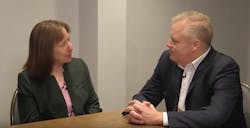At the Microgrid 2017 conference, Michael Carlson, president, Siemens Digital Grid NA, defines an intelligent microgrid and discusses the role of software in boosting the value of microgrids and providing services to the grid. He also describes two Siemens microgrid projects.
One of the things that sets microgrids apart is that they have an intelligent proponent — a brain, if you will. Microgrid Knowledge chief editor Elisa Wood asked Carlson how he would describe the “intelligent microgrid.”
Carlson pointed out that many of today’s microgrids have been established for a specific purpose, which starts with resilience and reliability. That’s why many of the early microgrids can be found at institutions like hospitals, colleges or the military.
Those installations have an “intelligence embedded within” that operates the machines for a discreet purpose, Carlson said.
[clickToTweet tweet=”One of the things that sets microgrids apart is that they have an intelligent proponent — a brain. #microgrids” quote=”One of the things that sets microgrids apart is that they have an intelligent proponent — a brain. #microgrids”]
But now, many are tapping the potential value in that microgrid equipment beyond its initial purpose, and the microgrid intelligence or brain is being expanded.
Siemens focuses not only on the intelligence of the individual equipment, but also on bringing together that intelligence into “a collaborative integration of data across the equipment spectrum, and arguably across the entire grid,” he continued.
Microgrid 2017 was sold out! Register now for Microgrid 2018 in Chicago.
In the interview, Carlson goes on to provide details about Siemens’ Blue Lake Rancheria microgrid project and how that particular intelligent microgrid works.
Carlson pointed out the California project is interesting from a variety of different perspectives: It is on an Indian reservation; at the end of a utility line; and far away from any other infrastructure.
“As their demands started to grow, they looked at options, including how PG&E could service them as a standard utility grid, and it was determined from an economic and operational and sustainability perspective that perhaps there was a different model,” Carlson said.
That different model turned out to be an intelligent microgrid, featuring Siemens microgrid controllers and device monitors.
View the video from Microgrid 2017 above to hear more from Carlson on a blockchain microgrid project in Brooklyn.
Michael Carlson is president of Siemens Digital Grid NA.
Read more about microgrid projects. Subscribe to the free Microgrid Knowledge newsletter.







